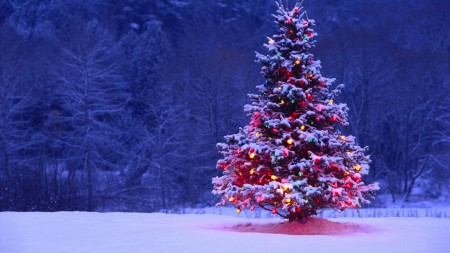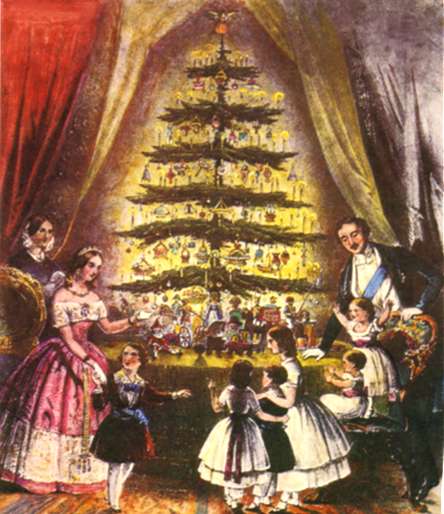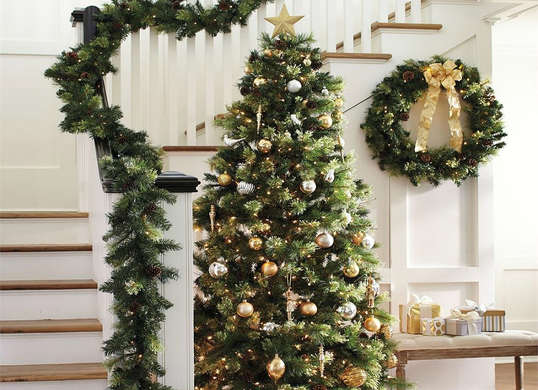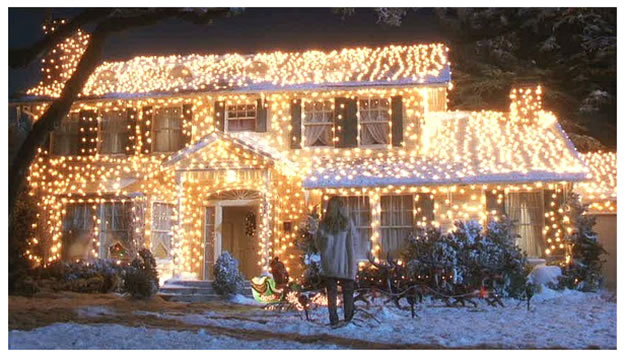Fun facts, all you ever needed to know about Christmas trees
 OK, so where did it all begin — this enthusiasm for dragging a fir tree into the house to decorate for Christmas? Not with Queen Victoria and her hubby Prince Albert, as many people think.
OK, so where did it all begin — this enthusiasm for dragging a fir tree into the house to decorate for Christmas? Not with Queen Victoria and her hubby Prince Albert, as many people think.
The evergreen fir tree has traditionally been used to celebrate winter festivals (pagan and Christian) for thousands of years. Pagans used branches of it to decorate their homes during the winter solstice, as it made them think of the spring to come. The Romans used Fir Trees to decorate their temples at the festival of Saturnalia. Christians use it as a sign of everlasting life with God.
Nobody is really sure when Fir trees were first used as Christmas trees. It probably began about 1000 years ago in Northern Europe. Many early Christmas Trees seem to have been hung upside down from the ceiling using chains (hung from chandeliers/lighting hooks).
Other early Christmas Trees, across many parts of northern Europe, were cherry or hawthorn plants (or a branch of the plant) that were put into pots and brought inside so they would hopefully flower at Christmas time. If you couldn't afford a real plant, people made pyramids of woods and they were decorated to look like a tree with paper, apples and candles. Sometimes they were carried around from house to house, rather than being displayed in a home. It's possible that the wooden pyramid trees were meant to be like Paradise Trees. These were used in medieval German Mystery or Miracle Plays that were acted out in front of Churches on Christmas Eve. In early church calendars of saints, 24th December was Adam and Eve's day. The Paradise Tree represented the Garden of Eden. It was often paraded around the town before the play started, as a way of advertising the play. The plays told Bible stories to people who could not read.
 The first documented use of a tree at Christmas and New Year celebrations is in town square of Riga, the capital of Latvia, in the year 1510. In the square there is a plaque which is engraved with "The First New Year's Tree in Riga in 1510", in eight languages. A picture from Germany in 1521 which shows a tree being paraded through the streets with a man riding a horse behind it. The man is dressed a bishop, possibly representing St. Nicholas.
The first documented use of a tree at Christmas and New Year celebrations is in town square of Riga, the capital of Latvia, in the year 1510. In the square there is a plaque which is engraved with "The First New Year's Tree in Riga in 1510", in eight languages. A picture from Germany in 1521 which shows a tree being paraded through the streets with a man riding a horse behind it. The man is dressed a bishop, possibly representing St. Nicholas.
The first first person to bring a Christmas Tree into a house, in the way we know it today, may have been the 16th century German preacher Martin Luther. A story is told that, one night before Christmas, he was walking through the forest and looked up to see the stars shining through the tree branches. It was so beautiful, that he went home and told his children that it reminded him of Jesus, who left the stars of heaven to come to earth at Christmas. Some people say this is the same tree as the 'Riga' tree, but it isn't! The Riga tree originally took place a few decades earlier. Northern Germany and Latvia are neighbors.
In Germany, the first Christmas Trees were decorated with edible things, such as gingerbread and gold covered apples. Then glass makers made special small ornaments similar to some of the decorations used today. In 1605 an unknown German wrote: "At Christmas they set up fir trees in the parlours of Strasbourg and hang thereon roses cut out of many-coloured paper, apples, wafers, gold foil, sweets, etc."
 The first Christmas Trees came to Britain sometime in the 1830s. They became very popular in 1841, when Prince Albert (Queen Victoria's German husband) had a Christmas Tree set up in Windsor Castle. In 1848, drawing of "The Queen's Christmas tree at Windsor Castle" was published in the Illustrated London News. The drawing was republished in Godey's Lady's Book, Philadelphia in December 1850 (but they removed the Queen's crown and Prince Albert's moustache to make it look 'American'!).
The first Christmas Trees came to Britain sometime in the 1830s. They became very popular in 1841, when Prince Albert (Queen Victoria's German husband) had a Christmas Tree set up in Windsor Castle. In 1848, drawing of "The Queen's Christmas tree at Windsor Castle" was published in the Illustrated London News. The drawing was republished in Godey's Lady's Book, Philadelphia in December 1850 (but they removed the Queen's crown and Prince Albert's moustache to make it look 'American'!).
The publication of the drawing helped Christmas Trees become popular in the UK and USA.
In Victorian times, the tree would have been decorated with candles to represent stars. In many parts of Europe, candles are still used to decorate Christmas trees.
Tinsel was also created in Germany, were it was originally made from thin strips of beaten silver. But when plastic/man made tinsel was invented, it became very popular as it was much cheaper than real silver and also lighter to go on the tree!
Because of the danger of fire, in 1895 Ralph Morris, an American telephonist, invented the first electric Christmas lights, similar to the ones we use today.
In 1885 a hospital in Chicago burned down because of candles on a Christmas Tree! And in 1908 insurance companies in the USA tried to get a law made that would ban candles from being used on Christmas Trees because of the many fires they had caused! So we have to say a big thank you to Ralph Morris for making Christmas safer!
The most lights lit at the same time on a Christmas tree is 194,672 and was done by Kiwanis Malmedy / Haute Fagnes Belgium in Malmedy, Belgium, on 10 December 2010!
Many towns and villages have their own Christmas Trees. One of the most famous is the tree in Trafalgar Square in London, England, which is given to the UK by Norway every year as a 'thank you' present for the help the UK gave Norway in World War II. The White House in the USA has had a big tree on the front lawn since the 1920s.
 The record for the most Christmas trees chopped down in two minutes is 27 and belongs to Erin Lavoie from the USA. She set the record on 19th December 2008 on the set of Guinness World Records: Die GroBten Weltrekorde in Germany.
The record for the most Christmas trees chopped down in two minutes is 27 and belongs to Erin Lavoie from the USA. She set the record on 19th December 2008 on the set of Guinness World Records: Die GroBten Weltrekorde in Germany.
Artificial Christmas Trees really started becoming popular in the early 20th century. In the Edwardian period Christmas Trees made from colored ostrich feathers were popular at 'fashionable' parties. Around 1900 there was even a short fashion for white trees - so if you thought colored trees are a new invention they're not! Over the years artificial tress have been made from feathers, papier mâché, metal, glass, and many different types of plastic (I've got a couple of inflatable trees!).
The tallest artificial Christmas tree was 52m (170.6ft) high and was covered in green PVC leaves!. It was called the 'Peace Tree' and was designed by Grupo Sonae Distribuição Brasil and was displayed in Moinhos de Vento Park, Porto Alegre, Brazil from 1st December 2001 until 6th January 2002.
In many countries, different trees are used as Christmas trees. In New Zealand a tree called the 'Pohutakawa' that has red flowers is sometimes used and in India, Banana or Mango trees are sometimes decorated.
Best cut tree
Noble fir is perfect because of its sturdy, bauble-bearing branches and minimal needle drop. Nordmann and Fraser firs come a close second, followed by Douglas and Grand fir.
For the first time, Silver Bells Blue, a blue-needled Noble, is available this year. No one knows how popular it will be. Most people pay between $60 and $80 for a 1.8-2.1 m (6-7 foot) tree.
Artificial trees
Pre-lit, easy-to-assemble trees are bestsellers and often the only choice for apartment dwellers, who are not allowed real trees. Prices range from $150 to $900. Pros: No mess, reusable. Cons: Non-recyclable, need to be put away carefully or can be damaged and stop working. Themed decorations (owls, whales, mermaids, foxes, flags, boats and seagulls) or mono-coloured trees (red, blue, white, pink and black) are popular.
Living trees
Scotch pine, Serbian spruce and Colorado spruce are all sold at garden centres as living trees in pots. They are brought inside for a maximum of 3-5 days and then planted in the garden. The key is to move them slowly back outside, allowing them to sit in the cool of a garage for a few days before planting.
U-cut
You can still cut your own Christmas tree at one of the dozens of Christmas tree farms in the Lower Mainland.
For a complete list, go to bcchristmastrees.com. These trees are grown as a crop and can be chipped and recycled as mulch.
Decorating trends
Foxes, owls, songbirds and bears are all the top tree decorations. Jenny Popoff, Christmas tree designer for 18 years with Art Knapp Plantland in Port Coquitlam, says the natural look is big, with birds’ nests, birch twigs and leaves, trumpets and bells made from burlap, plus “anything that looks as if it came from the garden.”
However, people still want some sparkle and glitter with plenty of silver, gold or platinum accessories thrown in for a festive feel.
Popoff says cobalt blue decorations — dyed hydrangeas, blue bows and rich blue baubles — are the top colour trend, especially in Europe right now.
“We have these decorations in this colour but they probably won’t catch on here in a big way ’til next year,” she says.
Lighting trend
Steady or twinkling fairy white or multi-coloured LED lights are still the most popular. 1-2 Glow lights are the hottest new thing, designed to be put up in less than five minutes and offering multiple twinkle settings. Price: $89.99 from GardenWorks at Mandeville, Burnaby. See video at 1-2glow.com
Care tips
Cut a half-inch off the bottom of the trunk of the tree before setting it up to make sure it can drink properly. Place trees away from drafts and heat sources. Water regularly. With artificial trees, don’t try to cram them back into their store box; you risk bending or breaking the frames and snapping lights. Invest in a spacious storage bag.
SAFETY
 While aesthetically appealing, holiday lighting displays can also be quite dangerous. However, some simple safety precautions are all it takes to ensure this year's lighting display is both stunning and safe.
While aesthetically appealing, holiday lighting displays can also be quite dangerous. However, some simple safety precautions are all it takes to ensure this year's lighting display is both stunning and safe.
- Make sure exterior lights are designed for outdoor use. Not all lights can handle the elements, so those old Christmas tree lights might not be able to enjoy a second life as part of a home's exterior lighting decor.
- Plug lights directly into the electrical sockets rather than relying heavily on extension cords. Employ surge protector strips if there are not enough outlets available. Before plugging anything in, consult the fuse box to determine how much each circuit can safely handle.
- Don't used damaged lighting sets, including those with frayed strings, unstable connections, exposed wires or broken or cracked sockets.
- Make sure all external lights are securely attached. Wind can do significant damage to bulbs, which can lead to additional safety risks. As a precaution, attach all lights firmly to walls or anything else that will not blow away when a stiff wind arrives.
- Inside the home, be extra careful when using an artificial Christmas tree. Electric lights should never be used on a metallic tree.
 - Routinely check the temperature of all electrical cords. If a cord feels too hot, unplug it and find a replacement.
- Routinely check the temperature of all electrical cords. If a cord feels too hot, unplug it and find a replacement.
- Don't leave the lights on when no adults are home. If the home is empty or if just kids are home, make sure the lights are off. Avoid using timers that automatically turn the lights on, as it's possible they will turn on when no one is home. Unplug all cords when going away for the holidays, just to be safe.
- Make sure all cords are visible. Don't bury cords underneath rugs or floor mats.
- Hanging lights shouldn't be a solo project. Whether hanging lights inside or outside, never do so alone. A stiff wind might come along and blow the ladder away or an unstable ladder might lead to a fall. Accidents happen when hanging lights indoors as well, so make sure to have an adult partner on hand to avoid injury.
- Make sure kids cannot reach lighting displays. Kids often adore holiday lighting displays and their natural curiosity is to reach for lights. Avoid potential accidents by keeping lights well beyond the reach of children.
© http://blogs.vancouversun.com/2015/12/08/christmas-tree-fun-facts/
© http://www.canada.com/Safety+first+when+stringing+holiday+lights/3939362/story.html
Posted by Steve Harmer on
Leave A Comment